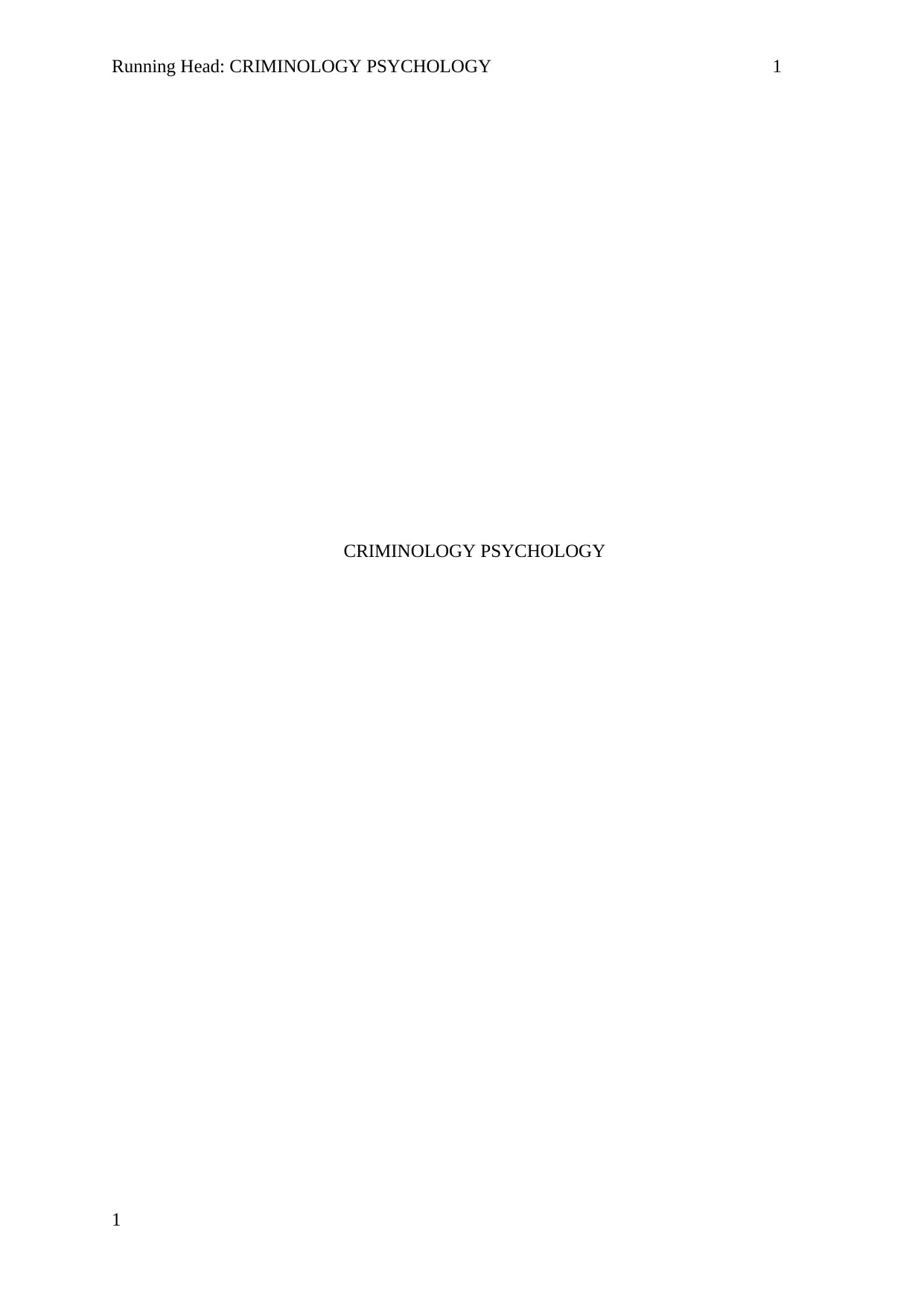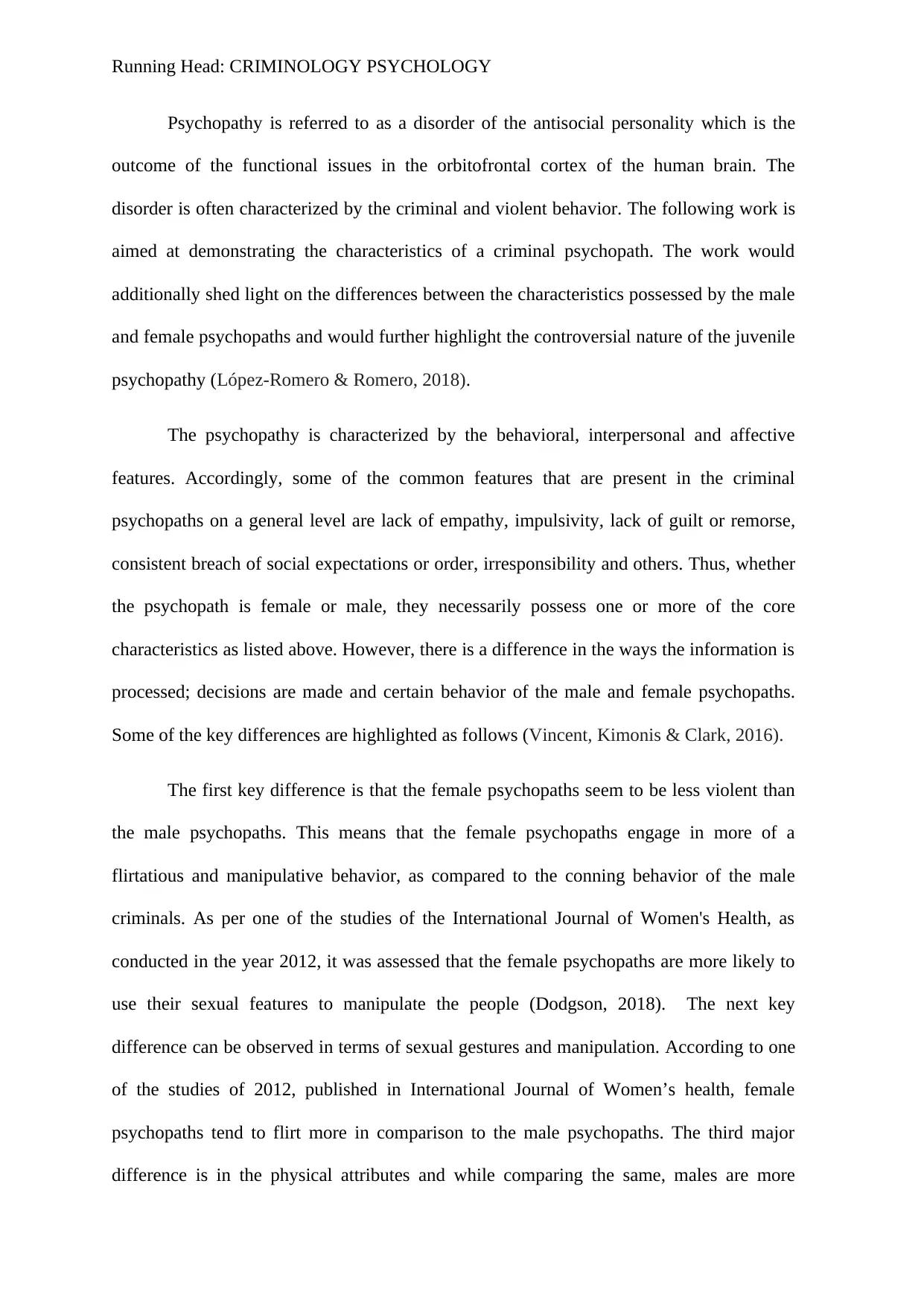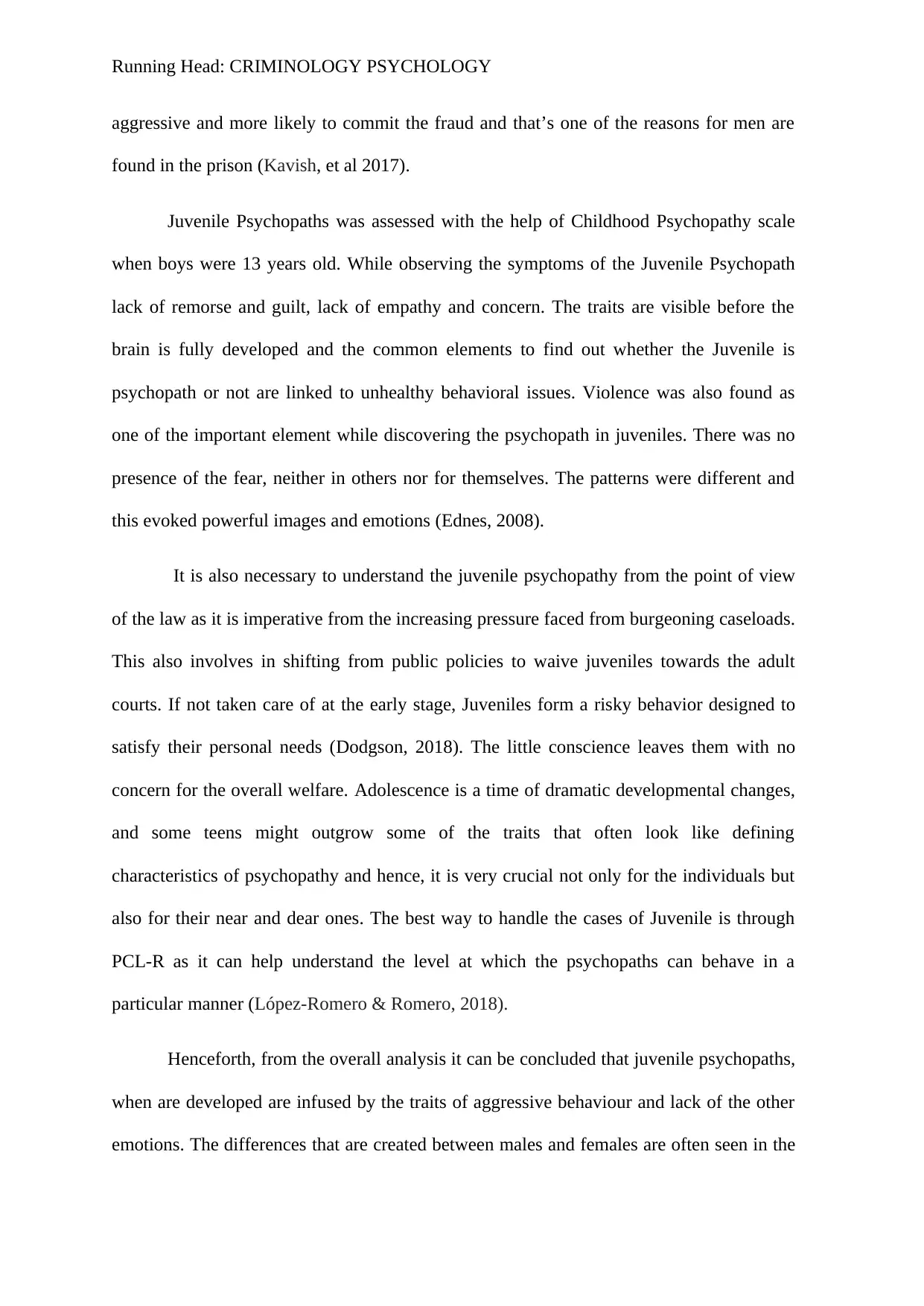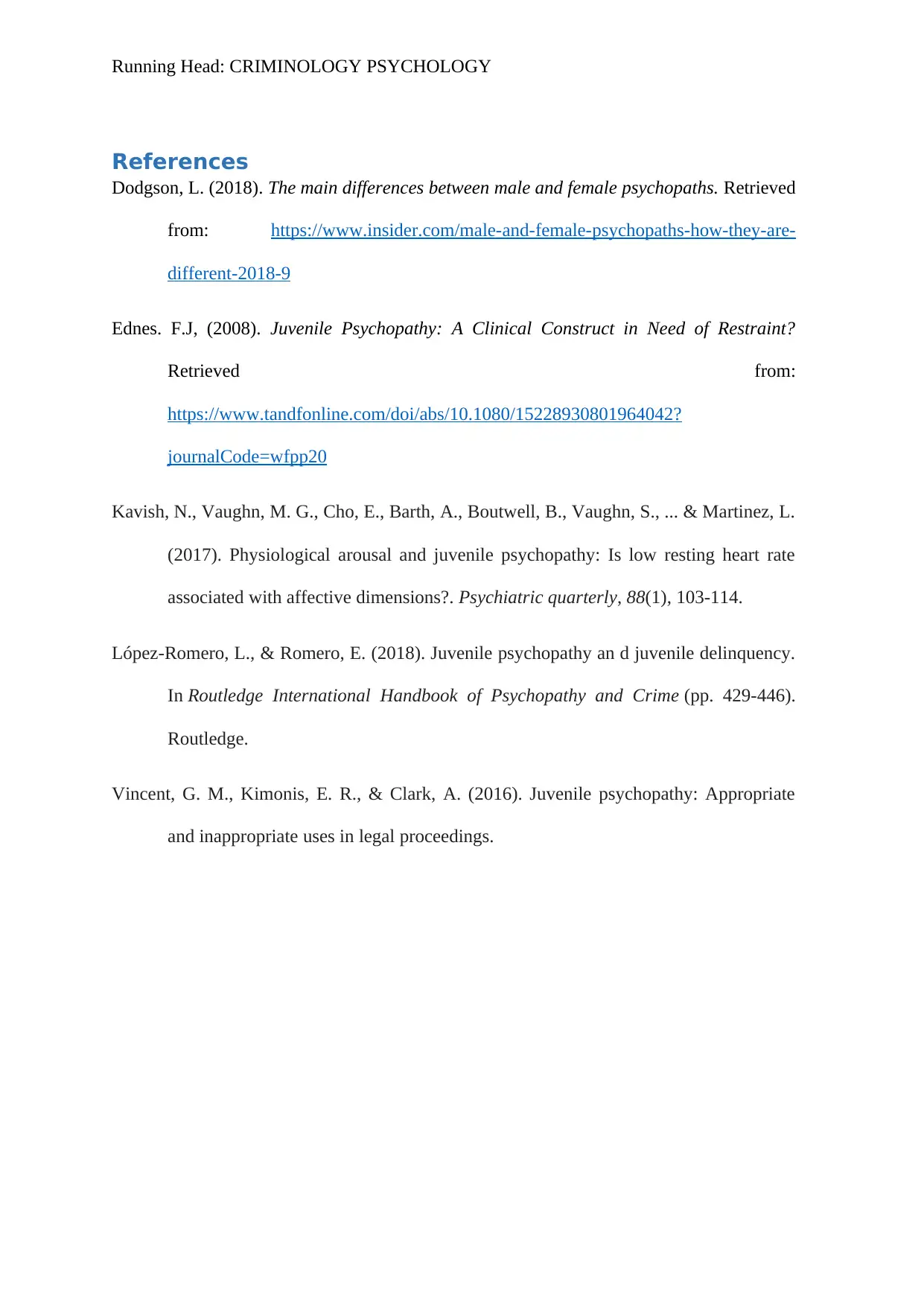Criminology Psychology: Male vs Female Criminal Psychopaths Analysis
VerifiedAdded on 2022/08/22
|5
|960
|15
Report
AI Summary
This report delves into the characteristics of criminal psychopathy, defined as an antisocial personality disorder stemming from orbitofrontal cortex dysfunction, often marked by criminal and violent behavior. It highlights key features such as lack of empathy, impulsivity, and irresponsibility. The report differentiates between male and female psychopaths, noting that females often exhibit less violent but more manipulative behaviors, using sexual features more frequently. It further examines juvenile psychopathy, emphasizing the importance of early identification and the potential for aggressive behavior and lack of fear. The report concludes by underlining the significance of tools like the PCL-R in understanding and managing psychopathic behavior, and the behavioral traits that can be identified in juveniles.

Running Head: CRIMINOLOGY PSYCHOLOGY 1
CRIMINOLOGY PSYCHOLOGY
1
CRIMINOLOGY PSYCHOLOGY
1
Paraphrase This Document
Need a fresh take? Get an instant paraphrase of this document with our AI Paraphraser

Running Head: CRIMINOLOGY PSYCHOLOGY
Psychopathy is referred to as a disorder of the antisocial personality which is the
outcome of the functional issues in the orbitofrontal cortex of the human brain. The
disorder is often characterized by the criminal and violent behavior. The following work is
aimed at demonstrating the characteristics of a criminal psychopath. The work would
additionally shed light on the differences between the characteristics possessed by the male
and female psychopaths and would further highlight the controversial nature of the juvenile
psychopathy (López-Romero & Romero, 2018).
The psychopathy is characterized by the behavioral, interpersonal and affective
features. Accordingly, some of the common features that are present in the criminal
psychopaths on a general level are lack of empathy, impulsivity, lack of guilt or remorse,
consistent breach of social expectations or order, irresponsibility and others. Thus, whether
the psychopath is female or male, they necessarily possess one or more of the core
characteristics as listed above. However, there is a difference in the ways the information is
processed; decisions are made and certain behavior of the male and female psychopaths.
Some of the key differences are highlighted as follows (Vincent, Kimonis & Clark, 2016).
The first key difference is that the female psychopaths seem to be less violent than
the male psychopaths. This means that the female psychopaths engage in more of a
flirtatious and manipulative behavior, as compared to the conning behavior of the male
criminals. As per one of the studies of the International Journal of Women's Health, as
conducted in the year 2012, it was assessed that the female psychopaths are more likely to
use their sexual features to manipulate the people (Dodgson, 2018). The next key
difference can be observed in terms of sexual gestures and manipulation. According to one
of the studies of 2012, published in International Journal of Women’s health, female
psychopaths tend to flirt more in comparison to the male psychopaths. The third major
difference is in the physical attributes and while comparing the same, males are more
Psychopathy is referred to as a disorder of the antisocial personality which is the
outcome of the functional issues in the orbitofrontal cortex of the human brain. The
disorder is often characterized by the criminal and violent behavior. The following work is
aimed at demonstrating the characteristics of a criminal psychopath. The work would
additionally shed light on the differences between the characteristics possessed by the male
and female psychopaths and would further highlight the controversial nature of the juvenile
psychopathy (López-Romero & Romero, 2018).
The psychopathy is characterized by the behavioral, interpersonal and affective
features. Accordingly, some of the common features that are present in the criminal
psychopaths on a general level are lack of empathy, impulsivity, lack of guilt or remorse,
consistent breach of social expectations or order, irresponsibility and others. Thus, whether
the psychopath is female or male, they necessarily possess one or more of the core
characteristics as listed above. However, there is a difference in the ways the information is
processed; decisions are made and certain behavior of the male and female psychopaths.
Some of the key differences are highlighted as follows (Vincent, Kimonis & Clark, 2016).
The first key difference is that the female psychopaths seem to be less violent than
the male psychopaths. This means that the female psychopaths engage in more of a
flirtatious and manipulative behavior, as compared to the conning behavior of the male
criminals. As per one of the studies of the International Journal of Women's Health, as
conducted in the year 2012, it was assessed that the female psychopaths are more likely to
use their sexual features to manipulate the people (Dodgson, 2018). The next key
difference can be observed in terms of sexual gestures and manipulation. According to one
of the studies of 2012, published in International Journal of Women’s health, female
psychopaths tend to flirt more in comparison to the male psychopaths. The third major
difference is in the physical attributes and while comparing the same, males are more

Running Head: CRIMINOLOGY PSYCHOLOGY
aggressive and more likely to commit the fraud and that’s one of the reasons for men are
found in the prison (Kavish, et al 2017).
Juvenile Psychopaths was assessed with the help of Childhood Psychopathy scale
when boys were 13 years old. While observing the symptoms of the Juvenile Psychopath
lack of remorse and guilt, lack of empathy and concern. The traits are visible before the
brain is fully developed and the common elements to find out whether the Juvenile is
psychopath or not are linked to unhealthy behavioral issues. Violence was also found as
one of the important element while discovering the psychopath in juveniles. There was no
presence of the fear, neither in others nor for themselves. The patterns were different and
this evoked powerful images and emotions (Ednes, 2008).
It is also necessary to understand the juvenile psychopathy from the point of view
of the law as it is imperative from the increasing pressure faced from burgeoning caseloads.
This also involves in shifting from public policies to waive juveniles towards the adult
courts. If not taken care of at the early stage, Juveniles form a risky behavior designed to
satisfy their personal needs (Dodgson, 2018). The little conscience leaves them with no
concern for the overall welfare. Adolescence is a time of dramatic developmental changes,
and some teens might outgrow some of the traits that often look like defining
characteristics of psychopathy and hence, it is very crucial not only for the individuals but
also for their near and dear ones. The best way to handle the cases of Juvenile is through
PCL-R as it can help understand the level at which the psychopaths can behave in a
particular manner (López-Romero & Romero, 2018).
Henceforth, from the overall analysis it can be concluded that juvenile psychopaths,
when are developed are infused by the traits of aggressive behaviour and lack of the other
emotions. The differences that are created between males and females are often seen in the
aggressive and more likely to commit the fraud and that’s one of the reasons for men are
found in the prison (Kavish, et al 2017).
Juvenile Psychopaths was assessed with the help of Childhood Psychopathy scale
when boys were 13 years old. While observing the symptoms of the Juvenile Psychopath
lack of remorse and guilt, lack of empathy and concern. The traits are visible before the
brain is fully developed and the common elements to find out whether the Juvenile is
psychopath or not are linked to unhealthy behavioral issues. Violence was also found as
one of the important element while discovering the psychopath in juveniles. There was no
presence of the fear, neither in others nor for themselves. The patterns were different and
this evoked powerful images and emotions (Ednes, 2008).
It is also necessary to understand the juvenile psychopathy from the point of view
of the law as it is imperative from the increasing pressure faced from burgeoning caseloads.
This also involves in shifting from public policies to waive juveniles towards the adult
courts. If not taken care of at the early stage, Juveniles form a risky behavior designed to
satisfy their personal needs (Dodgson, 2018). The little conscience leaves them with no
concern for the overall welfare. Adolescence is a time of dramatic developmental changes,
and some teens might outgrow some of the traits that often look like defining
characteristics of psychopathy and hence, it is very crucial not only for the individuals but
also for their near and dear ones. The best way to handle the cases of Juvenile is through
PCL-R as it can help understand the level at which the psychopaths can behave in a
particular manner (López-Romero & Romero, 2018).
Henceforth, from the overall analysis it can be concluded that juvenile psychopaths,
when are developed are infused by the traits of aggressive behaviour and lack of the other
emotions. The differences that are created between males and females are often seen in the
⊘ This is a preview!⊘
Do you want full access?
Subscribe today to unlock all pages.

Trusted by 1+ million students worldwide

Running Head: CRIMINOLOGY PSYCHOLOGY
form of the gestures and the postures. Overall the building of this type of the behaviour is
one of the reasons of the psychopaths and their evolvement.
form of the gestures and the postures. Overall the building of this type of the behaviour is
one of the reasons of the psychopaths and their evolvement.
Paraphrase This Document
Need a fresh take? Get an instant paraphrase of this document with our AI Paraphraser

Running Head: CRIMINOLOGY PSYCHOLOGY
References
Dodgson, L. (2018). The main differences between male and female psychopaths. Retrieved
from: https://www.insider.com/male-and-female-psychopaths-how-they-are-
different-2018-9
Ednes. F.J, (2008). Juvenile Psychopathy: A Clinical Construct in Need of Restraint?
Retrieved from:
https://www.tandfonline.com/doi/abs/10.1080/15228930801964042?
journalCode=wfpp20
Kavish, N., Vaughn, M. G., Cho, E., Barth, A., Boutwell, B., Vaughn, S., ... & Martinez, L.
(2017). Physiological arousal and juvenile psychopathy: Is low resting heart rate
associated with affective dimensions?. Psychiatric quarterly, 88(1), 103-114.
López-Romero, L., & Romero, E. (2018). Juvenile psychopathy an d juvenile delinquency.
In Routledge International Handbook of Psychopathy and Crime (pp. 429-446).
Routledge.
Vincent, G. M., Kimonis, E. R., & Clark, A. (2016). Juvenile psychopathy: Appropriate
and inappropriate uses in legal proceedings.
References
Dodgson, L. (2018). The main differences between male and female psychopaths. Retrieved
from: https://www.insider.com/male-and-female-psychopaths-how-they-are-
different-2018-9
Ednes. F.J, (2008). Juvenile Psychopathy: A Clinical Construct in Need of Restraint?
Retrieved from:
https://www.tandfonline.com/doi/abs/10.1080/15228930801964042?
journalCode=wfpp20
Kavish, N., Vaughn, M. G., Cho, E., Barth, A., Boutwell, B., Vaughn, S., ... & Martinez, L.
(2017). Physiological arousal and juvenile psychopathy: Is low resting heart rate
associated with affective dimensions?. Psychiatric quarterly, 88(1), 103-114.
López-Romero, L., & Romero, E. (2018). Juvenile psychopathy an d juvenile delinquency.
In Routledge International Handbook of Psychopathy and Crime (pp. 429-446).
Routledge.
Vincent, G. M., Kimonis, E. R., & Clark, A. (2016). Juvenile psychopathy: Appropriate
and inappropriate uses in legal proceedings.
1 out of 5
Related Documents
Your All-in-One AI-Powered Toolkit for Academic Success.
+13062052269
info@desklib.com
Available 24*7 on WhatsApp / Email
![[object Object]](/_next/static/media/star-bottom.7253800d.svg)
Unlock your academic potential
Copyright © 2020–2025 A2Z Services. All Rights Reserved. Developed and managed by ZUCOL.





